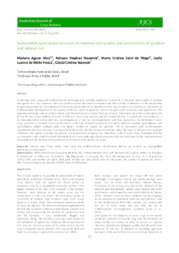Sustainable agricultural practices to improve soil quality and productivity of soybean and upland rice.
Sustainable agricultural practices to improve soil quality and productivity of soybean and upland rice.
Autoria: SILVA, M. A.; NASCENTE, A. S.; FILIPPI, M. C. C. de; FRASCA, L. L. de M.; REZENDE, C. C.
Resumo: Combining cover crops with multifunctional microorganisms provides significant increments in the grain productivity of soybean and upland rice crops. However, there are still few studies that aimed to evaluate the effect of this combination on the productivity of agricultural systems. The objective of this study was to determine the effect of the mix of cover crops and the co-inoculation of multifunctional rhizobacteria on the quality of the soil, yield components, and on the grain yield of soybean and upland rice. The experimental design was in random blocks with 24 treatments in a 6x2x2 factorial scheme. Treatments were the combination of 6 (5 mix of cover crops (mixture of seeds of different cover crops species) and the control (fallow), 2 (upland rice and soybeans), 2 (co-inoculated (inoculation with two microorganisms) or not (no microorganisms), with four replications. Combination of cover crops provided an increase in Ca and Mn levels in the soil, increased activity of soil quality indicator enzymes (phosphatase and arylsulfatase), higher soybean yield, and higher number of upland rice panicles. The co-inoculation with multifunctional rhizobacteria led to an increase in phosphorus levels in the soil, the number of pods per plant, the mass of 100 grains for soybean cultivation, the number of grains per panicle, and productivity of upland rice. Therefore, a mix of cover crops, combined with the co-inoculation with multifunctional rhizobacteria are sustainable agricultural practices that can contribute to the improvement of soil quality and the increase of the productivity of soybean and upland rice crops.
Ano de publicação: 2023
Tipo de publicação: Artigo de periódico
Unidade: Embrapa Arroz e Feijão
Palavras-chave: Arroz, Azozpirillum brasilense, Bacillus sp, Co-inoculation, Glycine Max, Oryza Sativa, Planta de Cobertura, Soja
Observações
1 - Por padrão são exibidas publicações dos últimos 20 anos. Para encontrar publicações mais antigas, configure o filtro ano de publicação, colocando o ano a partir do qual você deseja encontrar publicações. O filtro está na coluna da esquerda na busca acima.
2 - Para ler algumas publicações da Embrapa (apenas as que estão em formato ePub), é necessário ter, no celular ou computador, um desses softwares gratuitos. Sistemas Android: Google Play Livros; IOS: iBooks; Windows e Linux: software Calibre.
Acesse outras publicações
Acesse a Base de Dados da Pesquisa Agropecuária (BDPA) para consultar o acervo completo das bibliotecas da Embrapa.

